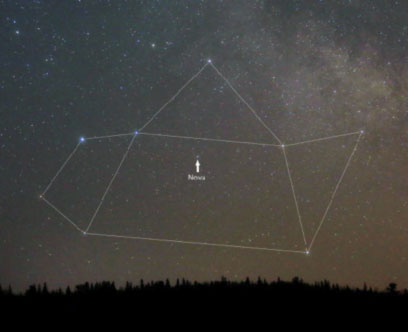Together with hydrogen and helium, lithium is one of the few elements created just after the "Big Bang", during the famous first three minutes of the Universe, 13.8 billion years ago. It is one of the lightest elements.
The quantity of lithium in the primordial universe was estimated theoretically and delimited by data furnished by the Planck satellite.
We know furthermore how much lithium is present in the oldest stars, which were created early in the history of the Universe.
In addition, the lithium abundance in meteorites tracks the quantity of lithium present during the formation of the solar system, 4,5 billion years ago.
And it turns out that the lithium abundance in meteorites is considerable, ten times higher than than in the oldest stars.
Whence came the lithium created during the life of the Universe ? There are a number of theoretical possibilities : AGB type stars, break-up of the interstellar matter by cosmic rays, supernovae ....
An important possibility : novae
Among binary systems consisting of two stars turning around each other, novae are among the most spectacular astronomical objects
In these systems, one star is a white dwarf, i.e. a very dense star representing the final stage in the evolution of low mass stars. Its size is that of a terrestrial size planet, but with a mass that of the Sun.
A white dwarf is so dense, that its gravity sucks in the material of its close companion star. When this material falls onto the white dwarf, its temperature rises sharply : it then radiates so much energy that a thermonuclear "cataclysmic" explosion results in the ejection of material at high speed (1000 km/s), leading to a violent increase in the luminosity of the star, of up to ten magnitudes.
The nova, called Sagittarii 2015, No. 2, discovered by an australian amateur astronomer, is attracting the interest of an international team of astrophycists.
Using ESO’s 8.2 m VLT, the scientists have manaaged to follow the evolution of the nova for 25 days, 57 days after its explosion. They have thus managed to estimate the quantity of lithium, via a measurement of that of the isotope7Be[1] <#_ftn1>.

A surprising result
The quantity of lithium produced corresponds to a concentration which is ten thousand times higher than that found in meteorites, i.e. a mass of 10^-9 solar masses.
Consequently, only a small fraction (2%) of all the novae in the Galaxy producing this quantity of lithium would suffice to explain 75% of the lithium abundance present during the formation of the Solar System.
The rest would be produced by the Big Bang and, in minute quantities, by the break up of the interstellar medium by cosmic rays.
This research has thrown new light on our understanding of lithium production in the Universe.
Reference
The work will be published as a letter in the journal MNRAS, authored by/P. Molaro INAF-Osservatorio Astronomico di Trieste, L. Izzo, from the Institute d’Astrophysique de l’Andalusie, E. Mason from theINAF-OATs, P. Bonifacio, from the Paris Observatory, and M. della Valle from the INAF-Osservatorio Astronomico di Napoli.///
